FEATURES OF LOCAL CORROSION OF WELDED JOINT OF PIPE STEEL X70 DUE TO ITS ELECTROCHEMICAL HETEROGENITY
DOI:
https://doi.org/10.30857/1813-6796.2020.4.11Keywords:
X70 pipe steel, potentiometry, polarization curve method, cathodic potential, electrochemical corrosion, stress corrosionAbstract
Establishing the influence of chemical composition and structure on local corrosion of the welded joint of X70 pipe steel in the conditions simulating operating conditions, and determining the main corrosion factors.Methodology. Standard methods were used: potentiometry, polarization curves method, research of corrosion resistance at constant deformation, profilometry, optical metallography. Results. The electrochemical heterogeneity of the welded joint (on the example of X70 steel) with the
factory weld was studied. It was found that in the weld of this joint has a slightly lower content compared to the base metal of the following elements: Al (0.025% and 0.02%, respectively) and Nb (0.033% and 0.058%, respectively), but a higher content of Mo and Cr. The structure of base metal is ferritic-bainite, has small pearlite formations, the structure of the seam is heterogeneous, contains dispersed needle, grain boundary polygonal, pre-eutectoid ferrite and separate areas of lamellar ferrite. It is concluded that in the welded joint under studied, the greater electrochemical activity of any zone can be attributed to the lower content of alloying elements or features of the microstructure. According to the results of electrochemical and accelerated corrosion-mechanical tests in the simulated operating conditions, it was found that the determinative factor for initiating of local corrosion of welded joints is the corrosive environment and conditions of the corrosion process flying, in particular – thin-film corrosion in a two-phase medium (hydrocarbon water). Scientific originality. According to the results of complex research, new data on the influence of the chemical composition and structure of the welded joints of steel X70 with factory extensional weld on the
susceptibility to local corrosion were obtained. It was found that in a welded joint, the greater electrochemical activity of any zone is due to the lower content of alloying additives (this applies to the weld
metal) and/or the peculiarities of the microstructure (for weld metal and high affected zone). Practical value. The methodological approach to investigation of local corrosion of welded joints in the conditions which are simulating the condition of operation, on an example of welded joints of X70 steel is developed and substantiate. A laboratory stand for research has been developed. It is established that the determinative factor for initiating of local corrosion of welded joints is the corrosive-active medium and the conditions of the corrosion process flying, particularly – thin-film corrosion in a two-phase medium (hydrocarbon-water).
Downloads
Download data is not yet available.
Downloads
Published
2021-03-10
Issue
Section
Chemical, Biological & Pharmaceutical Technologies

